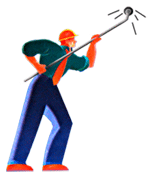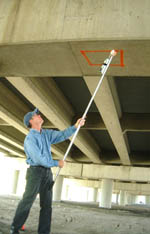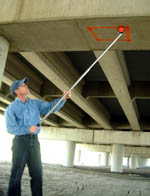
 The Delam Tool System by Sounding Technology, Inc |
The need for an accurate method for non-destructive testing for delaminations in reinforced concrete has led to the development of rotary percussion. Currently accepted in ASTM standard D 4580-86, rotary percussion is a method which uses non-destructive percussion similar to that of hammer tapping, but designed to cover large areas, including vertical and overhead structural elements, more easily and with a greater degree of accuracy.
Rotary percussion was developed out of a need to perform non-destructive sounding studies on overhead structural elements. The device and process are patented and are used to detect delaminated concrete in large top slab applications and in overhead surveys with greater speed and increased accuracy. The design of the tool includes a telescopic extension pole and a precision-machined tool head. The rotary percussion tool, known as the Delam Tool, is easily rolled over the subject area, striking the surface numerous times with 30 percussion points acting as 30 separate hammers. Overhead areas, which are typically out of reach, can be tested in most applications by extending the telescopic pole. The unique design of the pole allows it to remain rigid while fully extended. The tool head can be removed and hand held for close detailed examination. This speeds the entire process and causes far less fatigue than using a hammer or any other percussive device, and eliminates the need for ladders.
A set of companion tools which are used with the Delam Tool make the
process of detecting, marking, measuring and documenting delaminated areas
easier, faster and with greater accuracy.



|
Delam Tool 303 Sycamore Road Portsmouth, Virginia 23707 Phone: 757 630-5332
FAX (757) 227-9550 |
Copyright
© 2003-2006 Delam Tool |